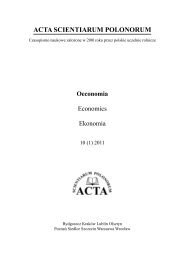INFORMATION SYSTEMS IN MANAGEMENT IV
INFORMATION SYSTEMS IN MANAGEMENT IV
INFORMATION SYSTEMS IN MANAGEMENT IV
You also want an ePaper? Increase the reach of your titles
YUMPU automatically turns print PDFs into web optimized ePapers that Google loves.
The demand for the product and replacement parts is typically forecast, and as aresult has a certain degree of uncertainty with respect to both the quantity demandedin a particular time period, and the timing of the quantity demanded.Hence, the existence of an inventory can be considered based on the fact that thelogistics process is not stable enough. Inventories function can be illustrated withhelp of Japanese manufacturing philosophy, “The Japanese Sea”, which was developedfrom the concept of removing all inventories in order to identify problems inthe company’s logistics processes. In other words, lowering the inventory levelsdiscloses problems that were previously hidden [5].The inventories are still used among the companies and, of course, the companiesdo not have to lower or eliminate its inventories. It is almost impossible as well asdangerous for a company to make an effort to solve all previously hidden problemsimmediately. Obviously, the cautious step-by-step process of lowering the inventorylevels in combination with the total logistics cost analysis seems to be the bestsolution.It is not a mistake to use inventories. However, the utilization of inventory demandseffective inventory management with defined inventory policy, order quantities,and inventory service levels. The objective of inventory management is toimprove the corporate profitability and increase customer service level with minimaltied up capital in inventory. However, the inventory management strategy hasto be seen in the greater perspective of the total logistics cost concept with possiblenegative consequences for other logistics costs. Furthermore, in the longer perspective,a company has to try to remove insecurities in the supply chain by establishingcollaboration with strategic suppliers.The main purpose of inventories is to act as a buffer between supply and demand.They allow operations to continue smoothly and avoid disruptions. There are ofcourse other reasons for holding inventories [16]:• to act as a buffer between different operations;• to allow for demands that are larger than expected, or at unexpected times;• to allow for deliveries that are delayed or are too small;• to take advantage of price discounts on large orders;• to buy items when price is low and expected to rise;• to buy items that are going out of production or are difficult to find;• to make full loads and reduce transport costs;• to give cover for emergencies.Problems of inventory management have been around for a very long time andpeople are still developing new ideas. A huge amount of work has been done todevelop the principles of effective inventory control, but it is still difficult to identifythe best policies. There is no ideal way of organizing stocks, and the best op-35
















